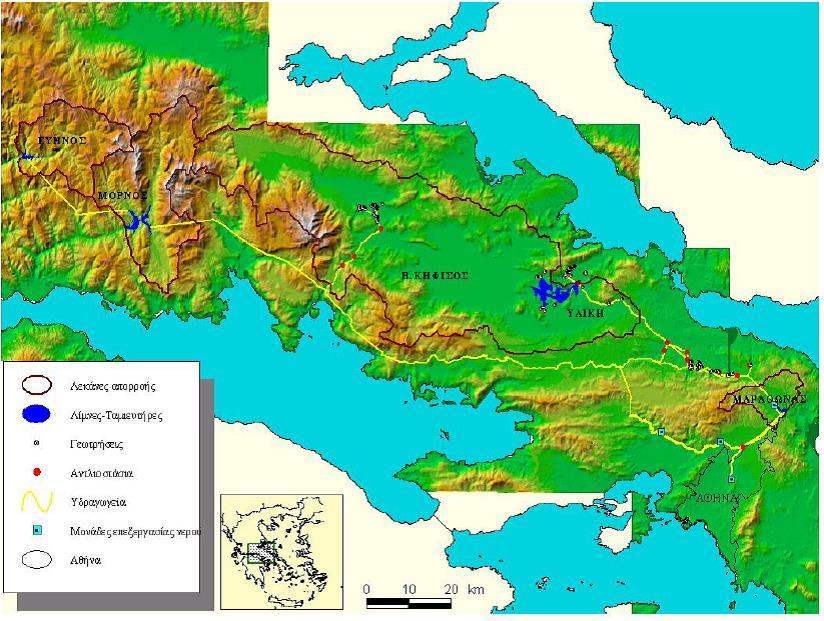
WATER SUPPLY SYSTEM OF ATTICA
Raw water is mainly supplied from surface water resources of the Marathon, Yliki, Mornos and Evinos catchments, classified in A2 category, in accordance with the European Directive 75/440/EEC on the quality required for surface water, intended for production of drinking water. Attica is supplied with one of the best quality waters in the world. The main sources of water abstraction and reservoirs that are used are located in pure areas, free from agricultural and industrial activity, so the Greek capital is supplied with high quality water.
The water supply system consists of:
- Surface and groundwater resources
- Surface water resources: (Mornos, Evinos, Boeotian Kifissos and Haradros rivers, Lake Yliki)
- Groundwater resources (aquifers with medium flow of Kifissos, Yliki and B.A. Parnitha)
- surface water storage infrastructure (reservoirs, dams, tanks)
- infrastructure for groundwater pumping (drilling)
- external aqueducts, aqueduct management projects (pumping stations, flow regulators)
- water treatment plants
- a network connecting the water treatment plants
Yliki is the only natural reservoir out of all the reservoirs and is currently used as an auxiliary water resource.
The Evinos Reservoir operates in conjunction with the Mornos Reservoir, enhancing the latter's water potential by diverting most of its upstream inflows.
The artificial Marathon Reservoir, created by the construction of a dam on the riverbed of the Haradros river, is mainly used for water storage, for safety reasons due to its proximity to Athens. Its level is kept to a limited relatively range so that a safety stock is always available and the risk of overflow is minimized, which would have a devastating impact on the downstream section of the Haradros River which has been trespassed to a great length.
The water transfer from the sources of water abstraction to the water treatment plants takes place through the following aqueducts, with a total length of 495km:
- Mornos Aqueduct - Main Aqueduct
- Yliki Aqueduct - Main Aqueduct
- Connecting Aqueduct of Mornos-Yliki - Connecting Aqueduct
- Connecting Aqueduct of Marathon-Galatsi - Connecting Aqueduct
- Connecting Aqueduct of Distomo - Connecting Aqueduct
- Evinos-Mornos Tunnel - Connecting Aqueduct
Despite the large distance of the main waterways (Mornos, Evinos) from Attica, most of the water is transported through the aqueducts by the gravity force, without any economic and environmental burden of energy-consuming pumps, which are activated only in emergencies.
The Marathon Reservoir
The Marathon Reservoir was created by the construction of a dam located in the Region of Attica, at the confluence of Haradros and Varnavas streams. Due to its proximity to Athens, the Marathon Reservoir operates as an auxiliary water source for emergency. It is supplied by the Yliki and Mornos reservoirs through the Yliki Aqueduct and the connecting aqueduct of Mornos - Yliki.
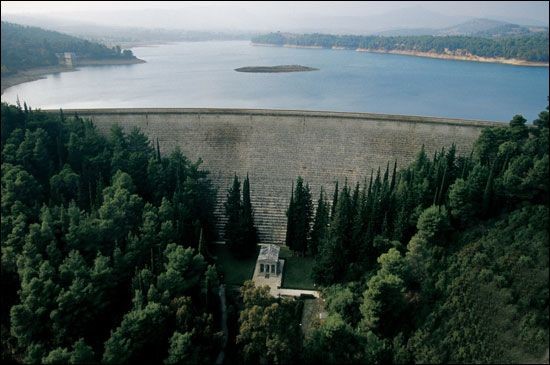
The Yliki Reservoir
The natural lake Yliki is located in the Region of Boeotia. Yliki joined the water supply system of Athens in 1956 in order to meet the great needs of water consumption due to the population increase of the Basin. Of the reservoirs of "EYDAP Fixed Assets" company, only that of Yliki is a naturally formed lake. Due to its low-altitude location, pumping stations are used to pump water that consume large amounts of energy, thus making the water transfer from Yliki a high-cost procedure. Just like the Marathon Reservoir, Yliki operates as an auxiliary water source of emergency.
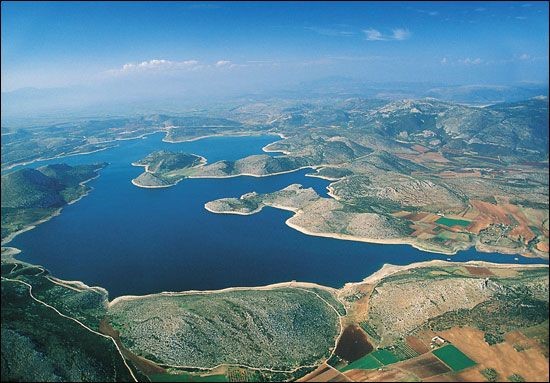
The Evinos - Mornos Tunnel
Through the Evinos - Mornos Tunnel, the waters of Evinos Reservoir are transported and channeled to the Mornos Reservoir, to strengthen its stock. The tunnel operates under pressure with a flow rate of 27 km of water per second. The Evinos - Mornos Tunnel has a total length of 29.393 m and an inner diameter of 3.5 m. The tunnel opening began in 1992 and was completed in 2 years, which is a great success for the completion of such a long tunnel.
The Mornos Reservoir
At the riverbed of Mornos river, 7 km west of Lidoriki in the Region of Fokida, was created the Mornos Reservoir by the construction of an earthen dam. The project began in May 1969 and was completed in 1979, but its normal operation began in 1981. The Mornos Dam, one of the largest dams in Europe, is made up of an impervious clay core.
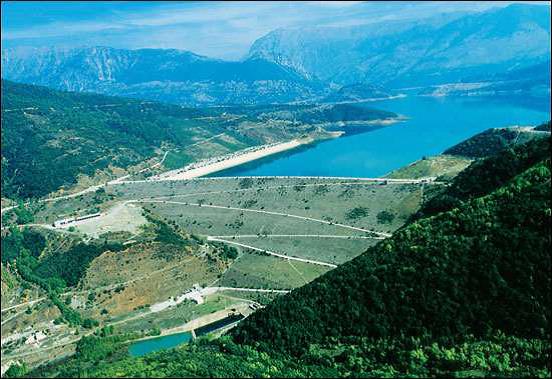
Evinos reservoir
On the Evinos river, in the area of Agios Dimitrios in the Region of Aitoloakarnania (Mountainous Nafpaktia), was constructed the Evinos project which included the construction of a dam, the creation of a reservoir and the construction of the Evinos-Mornos Tunnel. The design and implementation of this project envisaged the reinforcement of the main reservoir of Mornos by the neighboring river basin of Evinos. Works began on Evinos river in 1992 with the construction of an earthen dam, which was completed in 2001.
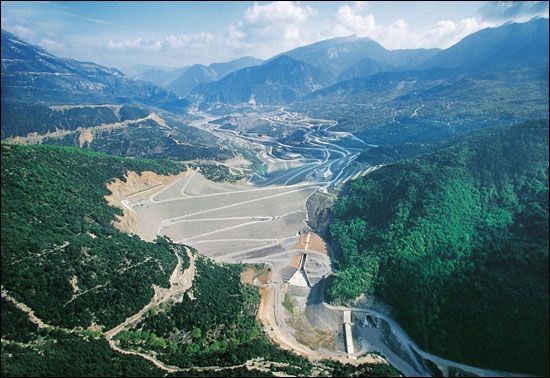
From ancient times to Ottoman rule
Athens has faced severe water scarcity problems since ancient times. Surface water was always scarce and the city was usually supplied by springs and wells. At the same time, there were many fountains scattered throughout the city, as well as many tanks for collecting rainwater.
One of the most famous ancient aqueducts was Peisistratio, built by the tyrant Peisistratos in 530 BC and pumped water from the springs of Ymittos. However, the most important project for the water supply of Athens was the Aqueduct of Hadrian, built in 134 AD up to 140 AD by the Roman Emperor Hadrian. The Hadrian's Aqueduct started at the foot of the mountain Parnitha and ended at Lycabettus, where the Hadrian's Tank was built.
The Hadrian's Aqueduct and Tank operated, supplying the area of Athens until the period of Ottoman rule. Then the Aqueduct was abandoned, causing its loose walls to fall. Under these conditions, the Athenians during the Ottoman rule turned to the construction of wells in their homes.
1833 - 1925
During the national liberation struggle many disasters occurred in the city's water supply infrastructure. Consequently, after the liberation, Athens' water supply problem was acute. At the initiative of the local authority, major works were carried out, such as repairs and cleaning of the Hadrian's Aqueduct, which re-opened in 1840.
In 1870 the Hadrian's Tank was also discovered, which was reconstructed and operated until 1940.
The construction of other small aqueducts was also important, but these projects did not have a significant impact on water scarcity. There were also about 55 municipal taps in Athens, which contributed a little, if not at all, to the daily needs of water consumption. For this reason, the water-sellers who transported and sold water to Athens from the springs of neighboring villages, such as Kifissia and Maroussi, increased significantly their sales.
1925 until today
The increase of population in Athens, mainly after the Asia Minor disaster, created new needs.
In 1925, the construction of the first modern water supply projects in the capital began, with the signing of a contract between the Greek State, the American Company ULEN and the Bank of Athens. The first major project was the construction of the Marathon Dam.
About 900 people worked on the dam's construction (1926 - 1929). The dam is coated with Pentelic marble, a particularity that makes it unique worldwide! The Boyati Tunnel, 13.4 km long was constructed for the water transport to Athens. In 1956, water of the natural Lake Yliki in Boeotia was used due to the continuing increase in the population of Athens. Lake Yliki has the particularity of being in a low altitude area. Thus, in order to allow water pumping, there are floating and overland pumping stations. Yliki's central pumping station is now the largest in Europe.
The technical project that was completed on the Mornos river in 1981 has major importance for the water supply of Athens. The dam located on the Mornos river is Europe's tallest earthen dam, being 126 meters high. Water reaches Athens through the Mornos aqueduct, the second largest aqueduct in Europe.
Another major project that boosts Athens's water supply is the diversion of the Evinos River to the Mornos Reservoir by the construction of a dam and tunnel, completed in 2001. The connecting supply tunnel that transports the water of Evinos to the Mornos reservoir, being 29.4km long, was completed in less than two years and that was a global achievement for the completion of a long tunnel.
Two large aqueducts, Mornos and Yliki, were constructed to transport raw water from the reservoirs to Attica, as well as connecting aqueducts through which the two main aqueducts communicate. Through the aqueducts of Mornos and Yliki, raw water is transported to the four Water Treatment Plants of Galatsi, Polydendri, Acharnes and Aspropyrgos.



